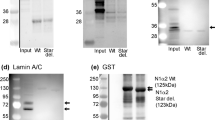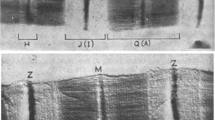Abstract
Using a monoclonal antibody, we have detected a high molecular weight muscle protein, co-localized and co-isolating with desmin. Searching a human cDNA database with partial amino acid sequences of the protein, we found a cDNA clone encoding a 1565-amino-acid polypeptide, identified as a mammalian (human) synemin, a member of the intermediate filament (IF) protein family. Immunoblotting showed the presence of a 180-kDa polypeptide in skeletal muscle and 180- and 200-kDa polypeptides in cardiac and smooth muscles. Interestingly, synemin was also found in myoepithelial cells, which have keratin filaments instead of desmin. Moreover, synemin was also found in astrocytes of optic nerves and non-myelin-forming Schwann cells, together with glial fibrillary acidic protein (GFAP) and vimentin. Blot overlays pointed to molecular interactions of synemin with desmin, vimentin, GFAP and keratin 5 and 6, but not with keratin 14. The experimental data also suggested a possible link with nebulin, a skeletal muscle protein. Purified synemin was coassembled with desmin in different molar ratios, and at 1:25, as typically found in vivo, IFs were formed which were comparable in length to desmin filaments. However, at molar ratios of 3:25 and 6:25, much shorter and irregular shaped filamentous polymers were generated. The fact that synemin is present in all four classes of muscle cells and a specific type of glial cells is indicative of important functions. Its incorporation may give structural and functional versatility to the IF cytoskeleton.









Similar content being viewed by others
References
Bellin RM, Sernett SW, Becker B, Ip W, Huiatt TW, Robson RM (1999) Molecular characteristics and interactions of the intermediate filament protein synemin. Interactions with alpha-actinin may anchor synemin-containing heterofilaments. J Biol Chem 274:29493–29499
Bellin RM, Huiatt TW, Critchley DR, Robson RM (2001) Synemin may function to directly link muscle cell intermediate filaments to both myofibrillar Z-lines and costameres. J Biol Chem 276:32330–32337
Bilak SR, Sernett SW, Bilak MM, Bellin RM, Stromer MH, Huiatt TW, Robson RM (1998) Properties of the novel intermediate filament protein synemin and its identification in mammalian muscle. Arch Biochem Biophys 355:63–76
Calvo JL, Carbonell AL, Boya J (1990) Coexpression of vimentin and glial fibrillary acidic protein in astrocytes of the adult rat optic nerve. Brain Res 532:355–357
Church GM, Gilbert W (1984) Genomic sequencing. Proc Natl Acad Sci U S A 81:1991–1995
Giudice GJ, Emery DJ, Diaz LA (1992) Cloning and primary structural analysis of the bullous pemphigoid autoantigen BP180. J Invest Dermatol 99:243–250
Granger BL, Lazarides E (1978) The existence of an insoluble Z disc scaffold in chicken skeletal muscle. Cell 15:1253–1268
Granger BL, Lazarides E (1980) Synemin: a new high molecular weight protein associated with desmin and vimentin filaments in muscle. Cell 22:727–738
Granzier HL, Wang K (1993) Gel electrophoresis of giant proteins: solubilization and silver-staining of titin and nebulin from single muscle fiber segments. Electrophoresis 14:56–64
Hatzfeld M, Maier G, Franke WW (1987) Cytokeratin domains involved in heterotypic complex formation determined by in-vitro binding assays. J Mol Biol 197:237–255
Hemken PM, Bellin RM, Sernett SW, Becker B, Huiatt TW, Robson RM (1997) Molecular characteristics of the novel intermediate filament protein paranemin. Sequence reveals EAP-300 and IFAPa-400 are highly homologous to paranemin. J Biol Chem 272:32489–32499
Hemmati-Brivanlou A, Mann RW, Harland RM (1992) A protein expressed in the growth cones of embryonic vertebrate neurons defines a new class of intermediate filament protein. Neuron 9:417–428
Herrmann H, Aebi U (2000) Intermediate filaments and their associates: multi-talented structural elements specifying cytoarchitecture and cytodynamics. Curr Opin Cell Biol 12:79–90
Hesse M, Magin TM, Weber K (2001) Genes for intermediate filament proteins and the draft sequence of the human genome: novel keratin genes and a surprisingly high number of pseudogenes related to keratin genes 8 and 18. J Cell Sci 114:2569–2575
Hieda Y, Nishizawa Y, Uematsu J, Owaribe K (1992) Identification of a new hemidesmosomal protein, HD1: a major, high molecular mass component of isolated hemidesmosomes. J Cell Biol 116:1497–1506
Hirako Y, Usukura J, Nishizawa Y, Owaribe K (1996) Demonstration of the molecular shape of BP180, a 180-kDa bullous pemphigoid antigen and its potential for trimer formation. J Biol Chem 271:13739–13745
Hirako Y, Tsujimura Y, Nishizawa Y, Owaribe K (1998) Novel muscle proteins associating with desmin. Cell Struct Funct 23:78 (Abstr)
Hisanaga S, Hirokawa N (1988) Structure of the peripheral domains of neurofilaments revealed by low angle rotary shadowing. J Mol Biol 202:297–305
Hori K, Hashimoto K, Eto H, Dekio S (1985) Keratin type intermediate filaments in sweat gland myoepithelial cells. J Invest Dermatol 85:453–459
Keller TC (1995) Structure and function of titin and nebulin. Curr Opin Cell Biol 7:32–38
Labeit S, Kolmerer B (1995) The complete primary structure of human nebulin and its correlation to muscle structure. J Mol Biol 248:308–315
Lendahl U, Zimmerman LB, McKay RD (1990) CNS stem cells express a new class of intermediate filament protein. Cell 60:585–595
Leung CL, Liem RK, Parry DA, Green KJ (2001) The plakin family. J Cell Sci 114:3409–3410
Marvin MJ, Dahlstrand J, Lendahl U, McKay RD (1998) A rod end deletion in the intermediate filament protein nestin alters its subcellular localization in neuroepithelial cells of transgenic mice. J Cell Sci 111:1951–1961
Mirsky R, Jessen KR (1986) The biology of non-myelin-forming Schwann cells. Ann N Y Acad Sci 486:132–146
Mizuno Y, Thompson TG, Guyon JR, Lidov HG, Brosius M, Imamura M, Ozawa E, Watkins SC, Kunkel LM (2001) Desmuslin, an intermediate filament protein that interacts with alpha-dystrobrevin and desmin. Proc Natl Acad Sci U S A 98:6156–6161
Moncman CL, Wang K (1996) Assembly of nebulin into the sarcomeres of avian skeletal muscle. Cell Motil Cytoskeleton 34:167–184
Nagase T, Ishikawa K, Nakajima D, Ohira M, Seki N, Miyajima N, Tanaka A, Kotani H, Nomura N, Ohara O (1997) Prediction of the coding sequences of unidentified human genes. VII. The complete sequences of 100 new cDNA clones from brain which can code for large proteins in vitro. DNA Res 4:141–150
Newey SE, Howman EV, Ponting CP, Benson MA, Nawrotzki R, Loh NY, Davies KE, Blake DJ (2001) Syncoilin, a novel member of the intermediate filament superfamily that interacts with alpha-dystrobrevin in skeletal muscle. J Biol Chem 276:6645–6655
Nishizawa Y, Uematsu J, Owaribe K (1993) HD4, a 180 kDa bullous pemphigoid antigen, is a major transmembrane glycoprotein of the hemidesmosome. J Biochem (Tokyo) 113:493–501
Nishizawa Y, Komori N, Usukura J, Jackson KW, Tobin SL, Matsumoto H (1999) Initiating ocular proteomics for cataloging bovine retinal proteins: microanalytical techniques permit the identification of proteins derived from a novel photoreceptor preparation. Exp Eye Res 69:195–212
Ohara O, Ohara R, Yamakawa H, Nakajima D, Nakayama M (1998) Characterization of a new beta-spectrin gene which is predominantly expressed in brain. Mol Brain Res 57:181–192
Owaribe K, Nishizawa Y, Franke WW (1991) Isolation and characterization of hemidesmosomes from bovine corneal epithelial cells. Exp Cell Res 192:622–630
Paramio JM, Casanova ML, Alonso A, Jorcano JL (1997) Keratin intermediate filament dynamics in cell heterokaryons reveals diverse behaviour of different keratins. J Cell Sci 110:1099–1111
Poon E, Howman EV, Newey SE, Davies KE (2002) Association of syncoilin and desmin: linking intermediate filament proteins to the dystrophin-associated protein complex. J Biol Chem 277:3433–3439
Purkis PE, Steel JB, Mackenzie IC, Nathrath WB, Leigh IM, Lane EB (1990) Antibody markers of basal cells in complex epithelia. J Cell Sci 97:39–50
Renner W, Franke WW, Schmid E, Geisler N, Weber K, Mandelkow E (1981) Reconstitution of intermediate-sized filaments from denatured monomeric vimentin. J Mol Biol 149:285–306
Schmid E, Schiller DL, Grund C, Stadler J, Franke WW (1983) Tissue type-specific expression of intermediate filament proteins in a cultured epithelial cell line from bovine mammary gland. J Cell Biol 96:37–50
Schweitzer SC, Klymkowsky MW, Bellin RM, Robson RM, Capetanaki Y, Evans RM (2001) Paranemin and the organization of desmin filament networks. J Cell Sci 114:1079–1089
Sejersen T, Lendahl U (1993) Transient expression of the intermediate filament nestin during skeletal muscle development. J Cell Sci 106:1291–1300
Steinert PM, Chou YH, Prahlad V, Parry DA, Marekov LN, Wu KC, Jang SI, Goldman RD (1999) A high molecular weight intermediate filament-associated protein in BHK-21 cells is nestin, a type VI intermediate filament protein. Limited co-assembly in vitro to form heteropolymers with type III vimentin and type IV alpha-internexin. J Biol Chem 274:9881–9890
Sugita H, Nonaka I, Itoh Y, Asakura A, Hu DH, Kimura S, Maruyama K (1987) Is nebulin the product of Duchenne muscular dystrophy gene? Proc Jpn Acad 63:107–110
Sultana S, Sernett SW, Bellin RM, Robson RM, Skalli O (2000) Intermediate filament protein synemin is transiently expressed in a subset of astrocytes during development. Glia 30:143–153
Titeux M, Brocheriou V, Xue Z, Gao J, Pellissier JF, Guicheney P, Paulin D, Li Z (2001) Human synemin gene generates splice variants encoding two distinct intermediate filament proteins. Eur J Biochem 268:6435–6449
Acknowledgements
We thank Dr. R. Kamiya (School of Science, University of Tokyo, Tokyo, Japan) and Dr. A. Kusumi (School of Science, Nagoya University, Nagoya, Japan) for their encouragement.
Author information
Authors and Affiliations
Corresponding author
Additional information
This work was supported by grants from the Ministry of Education, Science, and Culture of Japan.
Rights and permissions
About this article
Cite this article
Hirako, Y., Yamakawa, H., Tsujimura, Y. et al. Characterization of mammalian synemin, an intermediate filament protein present in all four classes of muscle cells and some neuroglial cells: co-localization and interaction with type III intermediate filament proteins and keratins. Cell Tissue Res 313, 195–207 (2003). https://doi.org/10.1007/s00441-003-0732-2
Received:
Accepted:
Published:
Issue Date:
DOI: https://doi.org/10.1007/s00441-003-0732-2




